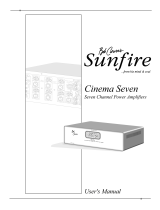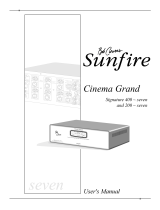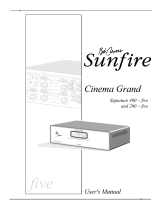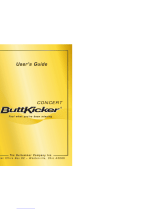Sunfire 913-047-00 User manual
- Category
- Musical Equipment
- Type
- User manual
Sunfire 913-047-00 is a Symphonic Reference Load Invariant High Fidelity Stereo Power Amplifier. It has two channels and can deliver 250 watts per channel into 8 ohms or 500 watts per channel into 4 ohms. The amplifier has an enormous power source that provides the ultimate muscle for limitless dynamics. It also has a peak-to-peak current output capability of 80 amperes per channel, which means that it can drive almost any load to any rationally usable current or voltage level.
Sunfire 913-047-00 is a Symphonic Reference Load Invariant High Fidelity Stereo Power Amplifier. It has two channels and can deliver 250 watts per channel into 8 ohms or 500 watts per channel into 4 ohms. The amplifier has an enormous power source that provides the ultimate muscle for limitless dynamics. It also has a peak-to-peak current output capability of 80 amperes per channel, which means that it can drive almost any load to any rationally usable current or voltage level.
















-
 1
1
-
 2
2
-
 3
3
-
 4
4
-
 5
5
-
 6
6
-
 7
7
-
 8
8
-
 9
9
-
 10
10
-
 11
11
-
 12
12
-
 13
13
-
 14
14
-
 15
15
-
 16
16
Sunfire 913-047-00 User manual
- Category
- Musical Equipment
- Type
- User manual
Sunfire 913-047-00 is a Symphonic Reference Load Invariant High Fidelity Stereo Power Amplifier. It has two channels and can deliver 250 watts per channel into 8 ohms or 500 watts per channel into 4 ohms. The amplifier has an enormous power source that provides the ultimate muscle for limitless dynamics. It also has a peak-to-peak current output capability of 80 amperes per channel, which means that it can drive almost any load to any rationally usable current or voltage level.
Ask a question and I''ll find the answer in the document
Finding information in a document is now easier with AI
Related papers
-
 Sunfire Cinema Seven User manual
Sunfire Cinema Seven User manual
-
 Sunfire Cinema Grand 200~seven User manual
Sunfire Cinema Grand 200~seven User manual
-
 Sunfire Cinema Grand Signature 400-five User manual
Sunfire Cinema Grand Signature 400-five User manual
-
 Sunfire Symphonic Reference High Fidelity Control Center and Preamplifier User manual
Sunfire Symphonic Reference High Fidelity Control Center and Preamplifier User manual
-
 Sunfire True Subwoofer EQ User manual
Sunfire True Subwoofer EQ User manual
-
 Sunfire 12 User manual
Sunfire 12 User manual
-
 Sunfire EQ Signature User manual
Sunfire EQ Signature User manual
-
 Sunfire Radio User manual
Sunfire Radio User manual
-
 Sunfire Ultimate Receiver User manual
Sunfire Ultimate Receiver User manual
-
 Sunfire TGA-5400(E) User manual
Sunfire TGA-5400(E) User manual
Other documents
-
Chord Symphonic User manual
-
Motorola RADIUS GM300 User manual
-
Chord Symphonic User manual
-
Motorola Professional GP640 Service Information
-
Motorola GM950E User manual
-
Motorola GTX/LTR 2000 User manual
-
Motorola GP2000 User manual
-
Motorola HSN1006A User manual
-
Radio Shack 32-2054 User manual
-
 The Guitammer Company BK-CT User manual
The Guitammer Company BK-CT User manual


























